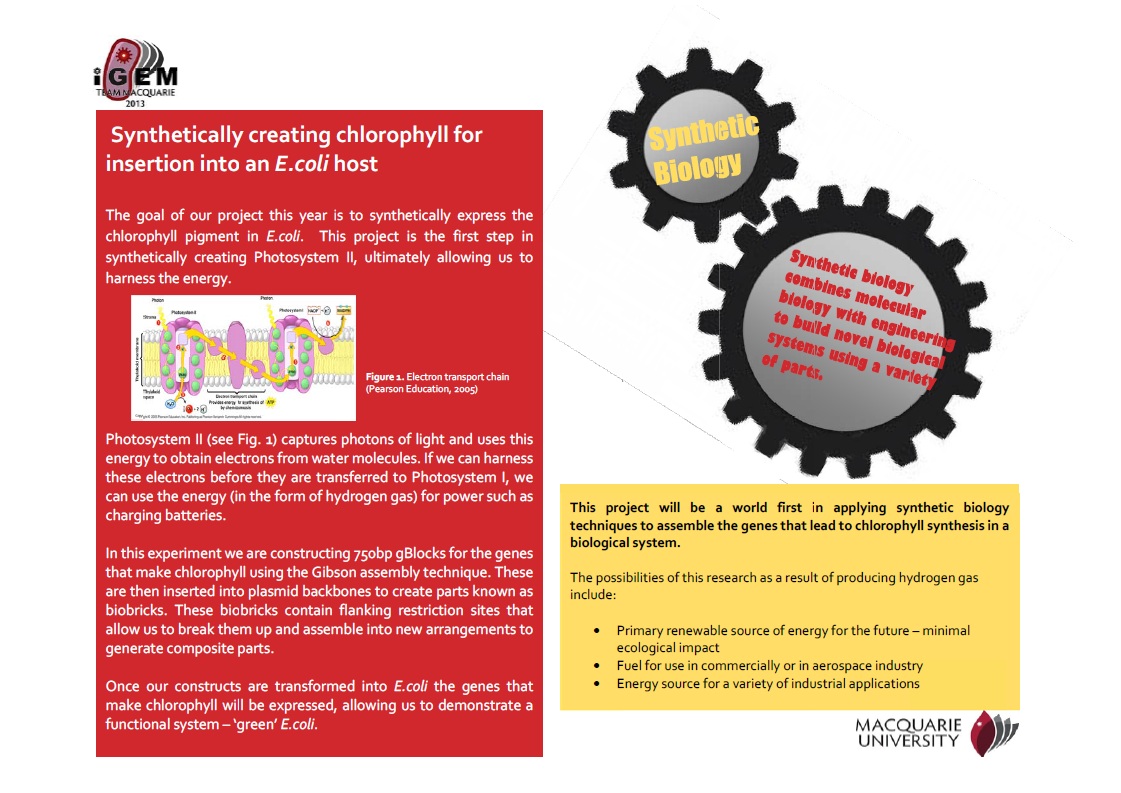Team:Macquarie Australia/Openday
From 2013.igem.org
(Difference between revisions)
| Line 15: | Line 15: | ||
<br><br> | <br><br> | ||
| - | <span style="color:#8B0000"><b>Chlorophyll Chromatography</b></span> | + | <span style="color:#8B0000"><font size = 3><b>Chlorophyll Chromatography</b></font size></span> |
<br><br> | <br><br> | ||
| Line 24: | Line 24: | ||
<br> | <br> | ||
| - | <span style="color:#8B0000"><b>Photosynthesis</b></span> | + | <span style="color:#8B0000"><font size = 3><b>Photosynthesis</font size></b></span> |
<br><br> | <br><br> | ||
| Line 33: | Line 33: | ||
<br> | <br> | ||
| - | <span style="color:#8B0000"><b>Glowing Plates</b></span> | + | <span style="color:#8B0000"><font size = 3><b>Glowing Plates</b></font size></span> |
<br><br> | <br><br> | ||
For the day we set up glowing plates, using fluorescent <I> E. coli </I> made using parts obtained from the registry. These plates provided an exciting and visual display for people to look at to show the simplicity created from the open source nature of synthetic biology. <br><br> | For the day we set up glowing plates, using fluorescent <I> E. coli </I> made using parts obtained from the registry. These plates provided an exciting and visual display for people to look at to show the simplicity created from the open source nature of synthetic biology. <br><br> | ||
| - | <span style="color:#8B0000"><b>Gibson Assembly | + | <span style="color:#8B0000"><b><font size = 3>Gibson Assembly Puzzle</b></font size></span> |
<br><br> | <br><br> | ||
| - | We also set up a Gibson assembly | + | We also set up a Gibson assembly puzzle along with a DNA model. We had team members present to help explain the process of these techniques and the advantages they provide us. <br><br> |
<br> | <br> | ||
| Line 47: | Line 47: | ||
<br> | <br> | ||
| - | <span style="color:#8B0000"><b>Magic Milk</b></span> | + | <span style="color:#8B0000"><font size = 3><b>Magic Milk</b></font size></span> |
<br><br> | <br><br> | ||
Revision as of 12:12, 26 September 2013




Macquarie University Open Day


Chlorophyll Chromatography
Why do leaves change colour? Through chlorophyll chromatography we answered this question. This hands on activity allowed people to perform a chromatography to observe the different pigments within leaves to show why leaves change colour. Further we also had team members on hand to explain this and provide the link with our project.

Photosynthesis
Like the chromatograph activity, a photosynthesis display was also set up the show part of the process. This display involved placing seaweed in a sealed test tube full of water, to show photosynthesis in action through the production of bubbles in the tube. Once again this provided a link to our project that was easy to explain to the general public.

Glowing Plates
For the day we set up glowing plates, using fluorescent E. coli made using parts obtained from the registry. These plates provided an exciting and visual display for people to look at to show the simplicity created from the open source nature of synthetic biology.
Gibson Assembly Puzzle
We also set up a Gibson assembly puzzle along with a DNA model. We had team members present to help explain the process of these techniques and the advantages they provide us.

Magic Milk
However the hit of the day was definitely the magic milk practical, where people were able to added different colour food dye to full cream milk, using micropipettes, the addition of detergent then provided the magic that entertained both the children and adults.

Plate 1: 17B (BBa_K864100)- Super Yellow Flurescent Protein
19I (BBa_K592100)- Blue Flurescent Protein
Plate 2: 2B (BBa_J63009)- Red Flurescent Protein- control
Plate 3: 5H (BBa_I13521- Red Flurescent Protein
5J (BBa_I13522)- Green Flurescent Protein
20C (BBa_I13600- Cyan Flurescent Protein
 "
"





